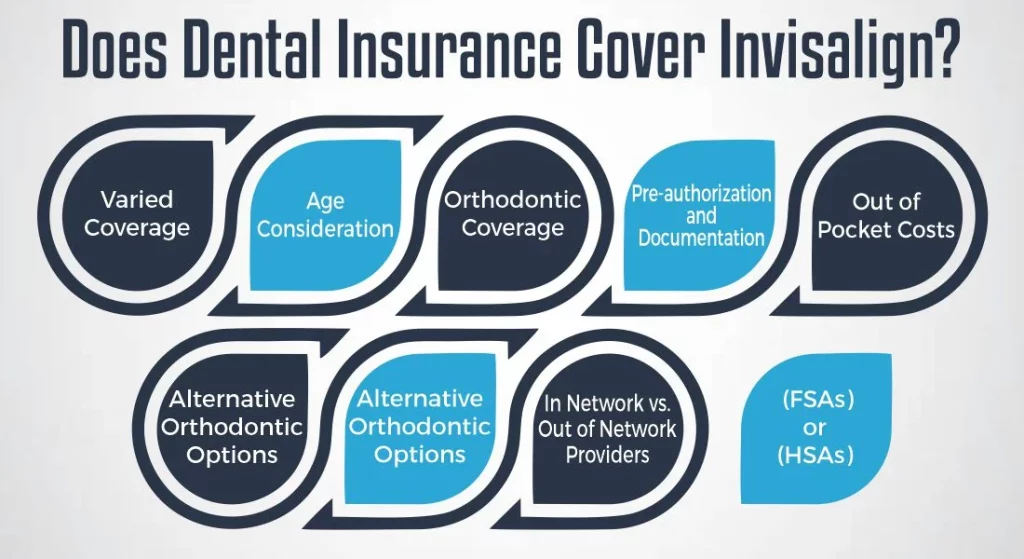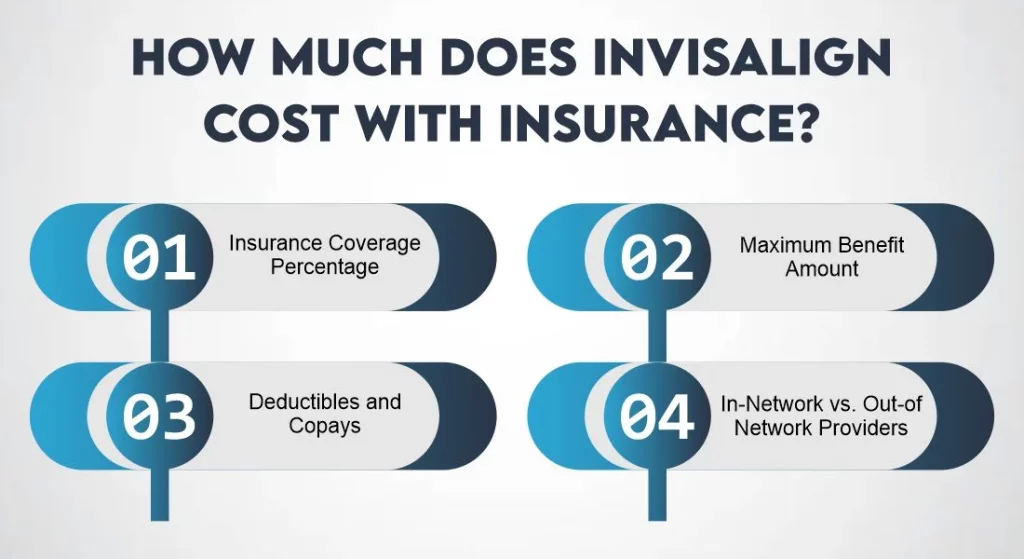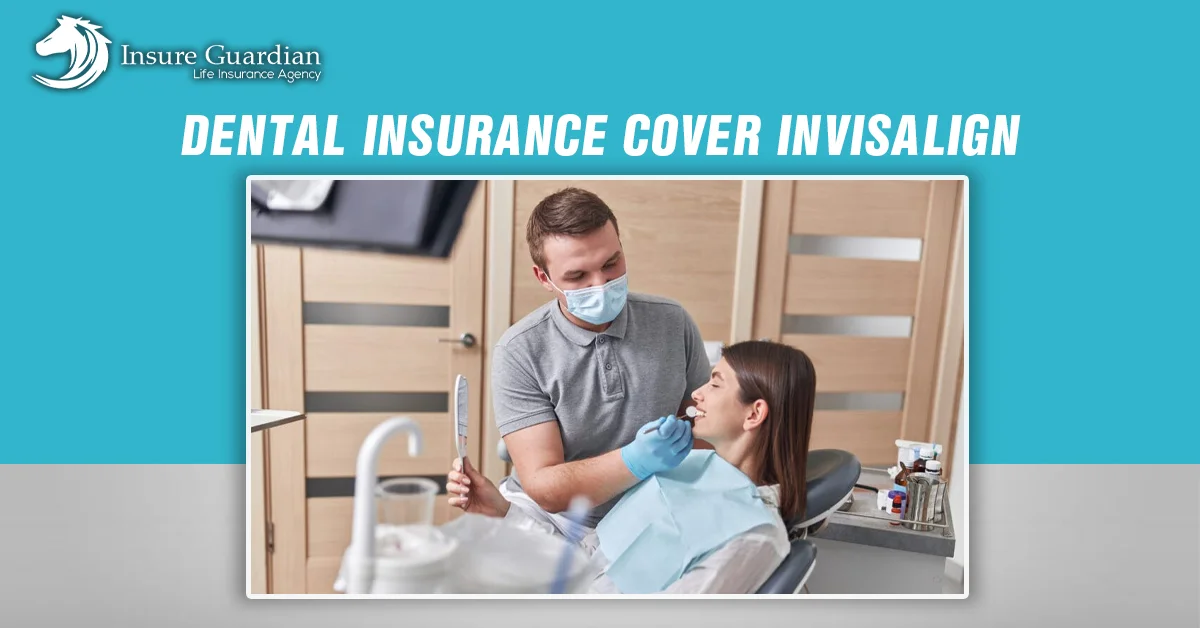When it comes to achieving that perfect smile, Invisalign has become a popular choice for many. It offers a discreet, convenient, and effective way to straighten teeth without the use of traditional metal braces. However, one common question that often arises is whether dental insurance cover Invisalign treatment.
This question isn’t as straightforward as we might hope. The territory of dental insurance is a maze of complexities, where definitions, limitations, and exclusions lurk in the fine print. Brace yourself, as we embark on a pragmatic journey to decode the enigmatic relationship between dental insurance and Invisalign.
In this comprehensive guide, we’ll delve into the world of Invisalign, exploring the treatment, dental insurance coverage, is invisalign covered by dental insurance and the costs involved.
So, if you’re pondering Invisalign treatment and how it aligns with your insurance coverage, get ready for a no-nonsense exploration into the complexities of this orthodontic odyssey. Your smile is the treasure; let’s uncover the map to financial clarity.
What is Invisalign Treatment?
Invisalign treatment is a modern orthodontic procedure designed to straighten misaligned teeth and correct various dental issues using a series of clear, custom-made aligners. Unlike traditional braces that rely on metal brackets and wires, Invisalign offers a more discreet, convenient, and comfortable alternative for achieving a straighter smile.
Here’s how the Invisalign treatment process typically works:
Consultation
The journey begins with a consultation with a qualified orthodontist or dentist experienced in Invisalign. During this initial visit, your dental professional will assess your teeth, discuss your specific dental concerns, and determine if Invisalign is a suitable option for you.
Customized Treatment Plan
If Invisalign is deemed appropriate for your needs, a customized treatment plan is created. Advanced 3D imaging technology is used to create a digital representation of your current teeth alignment and to visualize the desired final result.
Aligner Fabrication
Based on your treatment plan, a series of clear, thermoplastic aligners are custom-made for your teeth. These aligners are typically removable and should be worn for a specific period before moving on to the next set in the series.
Progressive Alignment
You’ll receive a series of aligners, each designed to make incremental adjustments to the positioning of your teeth. As you progress through the aligners, your teeth will gradually move toward the desired alignment.
Regular Check-ups
Throughout the treatment process, you’ll have periodic check-up appointments with your dental provider to monitor your progress and receive new sets of aligners.
Discreet and Comfortable
Invisalign aligners are virtually invisible when worn, making them a discreet option for orthodontic treatment. They are also removable, which means you can take them out for eating, drinking, and oral hygiene, providing greater convenience compared to traditional braces.
Treatment Duration
The duration of Invisalign treatment varies depending on the complexity of your case and the specific alignment issues you need to address. Treatment can last anywhere from several months to a couple of years.
Invisalign treatment is often used to correct a range of dental issues, including crowded teeth, gaps between teeth, overbites, underbites, cross bites, and more. It has gained popularity for its effectiveness and the aesthetic advantages it offers by being nearly invisible during wear.

Does Dental Insurance Cover Invisalign?
The main question arises is Invisalign covered by dental insurance? The coverage of Invisalign treatment by dental insurance varies widely and depends on the specific terms and conditions of your insurance plan. Here are some key points to consider regarding dental insurance covers Invisalign:
Varied Coverage: Some dental insurance plans do provide partial coverage for Invisalign treatment, while others may not cover it at all. The extent of coverage can differ significantly from one plan to another.
Age Consideration: Insurance coverage for Invisalign may also depend on your age. Some insurance plans may cover Invisalign for adults and children, while others may have age restrictions and limit coverage to younger patients.
Orthodontic Coverage: In many cases, coverage for Invisalign falls under the orthodontic portion of dental insurance. Orthodontic coverage typically has its own lifetime maximum, which may differ from the general dental coverage maximum.
Pre-authorization and Documentation: To determine if Invisalign is covered under your insurance plan, contact your insurance provider and inquire about their specific requirements. They may require pre-authorization, documentation from your orthodontist, or other verification forms.
Out-of-Pocket Costs: Even if your insurance covers Invisalign treatment, you may still be responsible for out-of-pocket costs. These costs can include deductibles, co-pays, and any expenses beyond the maximum coverage offered by your insurance.
Alternative Orthodontic Options: Your insurance plan may offer coverage for alternative orthodontic treatments, such as traditional braces, at a different rate than Invisalign. It’s important to understand the options available under your plan.
In-Network vs. Out-of-Network Providers: Dental insurance plans often have a network of preferred providers. If your orthodontist is within your plan’s network, you may receive a higher coverage level than an out-of-network provider.
Flexible Spending Accounts (FSAs) or Health Savings Accounts (HSAs): If you have an FSA or HSA, you can use these accounts to cover Invisalign expenses, even if your dental insurance doesn’t fully cover the treatment.
What is Invisalign Considered for Insurance?
Invisalign, a popular alternative to traditional metal braces, is often covered by dental insurance under the category of orthodontic care. This innovative treatment involves using a series of clear, removable aligners to straighten teeth, offering a less noticeable and more comfortable option for orthodontic patients. Given its benefits and effectiveness, many individuals opt for Invisalign, but insurance coverage is always questioned. Understanding how Invisalign is classified for insurance is crucial for patients considering this treatment.
Due to the variations in coverage, it’s essential for individuals considering Invisalign to check their dental insurance policy details or contact their insurance provider directly. This step will help clarify whether Invisalign is covered, the extent of the coverage, and any out-of-pocket costs they might expect. Understanding what is Invisalign considered for insurance can assist patients in making informed decisions about their orthodontic care and manage their treatment expenses more effectively.
What dental insurance covers Invisalign for adults?
Dental insurance coverage for Invisalign, especially for adults, can vary significantly across different providers and plans. However, many major dental insurance companies offer some coverage for Invisalign under their orthodontic benefits.
To determine what dental insurance covers Invisalign for adults, adults should thoroughly review their dental insurance plan or contact their insurance provider directly. Factors to inquire about include the percentage of treatment covered, lifetime maximums for orthodontic treatment, deductibles, co-payments, and any age restrictions or prerequisites for coverage. Additionally, verifying whether pre-approval is required for Invisalign treatment can help ensure a smoother process of obtaining coverage benefits.
How much does insurance cover Invisalign?
The coverage for Invisalign treatment by insurance varies significantly depending on your insurance plan and provider. Generally, if your dental insurance plan includes orthodontic benefits, Invisalign should be covered to the same extent as traditional braces.
This often ranges from a specific dollar amount to a percentage of the treatment cost, typically between 25% and 50%, with most plans having a lifetime orthodontic maximum benefit cap. It’s essential to check how much does insurance cover Invisalign, including any deductibles and co-pays and verify if your orthodontist is within your insurance network. Some plans may also have age restrictions or other prerequisites for coverage. Direct consultation with your insurance company and dental care provider is the best way to understand the extent of coverage for Invisalign under your particular insurance plan.
Which dental plans cover Invisalign?
Do you know which dental plans cover Invisalign? Many dental insurance plans offer some coverage for Invisalign, treating it similarly to traditional braces under orthodontic benefits. The specifics, however, can vary widely from one plan to another. Major insurance providers like Delta Dental, Aetna, Cigna, UnitedHealthcare, and Blue Cross Blue Shield often include orthodontic coverage that can be applied to Invisalign treatment, depending on the specific policy details. Coverage can range from a percentage of the treatment cost to a fixed dollar amount, typically subject to a lifetime orthodontic maximum.
It’s important to carefully review your insurance policy or speak directly with your insurance provider to understand which dental insurance covers Invisalign, including any limitations, deductibles, or co-pays. Additionally, some plans may require that the orthodontic treatment be deemed medically necessary or have age restrictions. For the most accurate and up-to-date information, contacting your insurance provider and consulting with your dental care provider is recommended, as they can assist in determining your coverage and any out-of-pocket costs for Invisalign treatment.
How Much Will Dental Insurance Cover for Invisalign?
The amount insurance will cover for Invisalign treatment can vary significantly based on your dental insurance plan. Insurance providers may have different policies, maximum benefit amounts, and coverage percentages. It’s essential to check your insurance policy and speak directly with your insurance provider to get accurate and up-to-date information on coverage. Here’s a general idea of what you might encounter:Invisalign Insurance Coverage Cost
| Coverage Type | Typical Percentage Covered | Maximum Benefit Amount |
|---|---|---|
| Orthodontic Coverage | 50% to 80% | Varies (e.g., $1,000 to $2,000) |
| Age Restrictions | May cover children or adults | Varies |
| Lifetime Maximum Benefit | May have a limit (e.g., $1,000 to $2,500) | Varies |
| Deductible | Applies before coverage begins | Varies |
| Copays and Out-of-Pocket Costs | You may be responsible for a portion | Varies |
| In-Network vs. Out-of-Network | In-network providers often have higher coverage | Varies |
- Contact your Dental Insurance Provider: Reach out to your insurance company’s customer service or claims department and ask about the specifics of your coverage for orthodontic treatment, including Invisalign.
- Obtain a Pre-Authorization: Many insurance providers require pre-authorization or pre-approval for orthodontic treatment. Your orthodontist or dentist can assist you in this process.
- Review your Policy: Carefully review your insurance policy documents, paying particular attention to the section on orthodontic coverage. This will provide you with detailed information about your coverage limits, percentages, and any age restrictions.
- Consult with your Orthodontist: Your orthodontist can also help you understand the cost breakdown and coverage specifics based on their experience working with various insurance plans.
 How Much Does Invisalign Cost With Insurance
How Much Does Invisalign Cost With InsuranceHow Much Does Invisalign Cost With Insurance?
The cost of Invisalign with insurance can be significantly lower compared to the cost without insurance, but the exact amount you’ll pay out of pocket depends on the terms and invisalign dental coverage of your specific dental insurance plan. Dental insurance that covers Invisalign can vary widely from one plan to another. Here’s what you can generally expect when calculating the Invisalign cost with insurance:1- Insurance Coverage Percentage
Dental insurance covers Invisalign typically includes a percentage of coverage for orthodontic treatment. This percentage can range from 50% to 80% or more. The percentage represents the portion of the total treatment cost that your insurance will cover.2- Maximum Benefit Amount
In addition to the coverage percentage, dental insurance plans often have a maximum benefit amount for orthodontic treatment. This is the highest dollar amount that the insurance plan will pay for your Invisalign treatment. The maximum benefit amount can vary significantly between insurance plans but may fall in the range of $1,000 to $2,500 or more.3- Deductibles and Copays
Most insurance plans have a deductible, which is an initial amount you must pay before your insurance coverage kicks in. After meeting the deductible, you’ll typically be responsible for co-pays, which represent your share of the treatment cost. The specific deductible and copay amounts are determined by your insurance plan.4- In-Network vs. Out-of-Network Providers
Dental insurance plans often have a network of preferred providers. When you choose an in-network orthodontist, you may receive a higher level of invisalign dental coverage. Using an out-of-network provider may result in reduced coverage and higher out-of-pocket costs.Cost of Invisalign without Insurance
The cost of Invisalign treatment without insurance can vary depending on several factors, including the complexity of your case, the geographic location of your dental provider, and any additional services that may be required. Here are some approximate cost ranges to give you a general idea:- Mild Cases: For mild alignment issues that require a shorter treatment duration, the cost of Invisalign can range from $2,500 to $4,500.
- Moderate Cases: Moderate cases with more complex alignment issues typically fall in the range of $4,500 to $6,500.
- Severe Cases: Severe cases that require extensive treatment and longer duration may cost between $6,500 and $8,000 or more.







